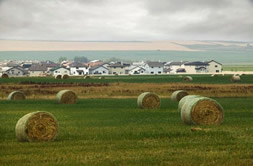What's happening to our farmland?
 Each
year you have to drive a little farther out to find
it. Slowed by traffic, through tangled
intersections, past rows of houses that seem to have
sprouted from the field, finally, you can see the
bountiful farmland. For the past two decades, we've
paved over our farmland for roads, houses and malls.
Wasteful land use puts America's farmland at risk,
especially our most fertile and productive—our most
valuable—farmland. Each
year you have to drive a little farther out to find
it. Slowed by traffic, through tangled
intersections, past rows of houses that seem to have
sprouted from the field, finally, you can see the
bountiful farmland. For the past two decades, we've
paved over our farmland for roads, houses and malls.
Wasteful land use puts America's farmland at risk,
especially our most fertile and productive—our most
valuable—farmland.
We're needlessly wasting one of the world's most
important resources. Less than one-fifth of U.S.
land is high quality, and we are losing this finest
land to development at an accelerating rate. U.S.
agricultural land provides the nation—and the
world—with an unparalleled abundance of food. But
farmland means much more than food. Well-managed
farmland shelters wildlife, supplies scenic open
space and helps filter impurities from our air and
water. These working lands keep our taxes down and
maintain the legacy of our agricultural heritage. It
makes no sense to develop our best farmland.
Instead, we have a responsibility to protect this
most valuable resource for future generations.
- In
America, we've been losing more than an acre of
farmland per minute.
Between 2002 and 2007, 4,080,300 acres of
agricultural land were converted to developed
uses—an area nearly the size of Massachusetts.
- Between 1982 and 2007,
41,324,800 acres of rural land (i.e., crop,
pasture, range, land formerly enrolled in CRP,
forest and other rural land) were converted to
developed uses. This represents and area about
the size of Illinois and New Jersey combined.
- During the 25-year span, every state
lost prime farmland.
States with the biggest losses included Texas
(1.5 million), Ohio (796,000), North Carolina
(766,000), California (616,000) and Georgia
(566,000).
- Between 2002 and 2007, 7,491,300 acres of
rural land were converted to developed uses—an
area nearly the size of Maryland. This amounts
to an average annual conversion rate of
1,498,200 acres.
-
Our food is increasingly in the path of
development.
An astounding 91% of our fruit and 78% of our
vegetables are produced in urban-influenced
areas.
- Wasteful land use is
the problem, not growth itself.
Wasteful land use is the problem, not
development itself. From 1982 to 2007, the U.S.
population grew by 30 percent. During the same
time period, developed land increased 57
percent.
Learn more about the
2007 National Resources Inventory report from which
these numbers are derived.
|